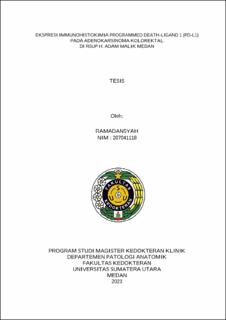Ekspresi Immunohistokimia Programmed Death-Ligand 1 (PD-L1) pada Adenokarsinoma Kolorektal di RSUP H. Adam Malik Medan

Date
2023Author
Ramadansyah, Ramadansyah
Advisor(s)
Alferraly, T. Ibnu
Chrestella, Jessy
Metadata
Show full item recordAbstract
Background: Colorectal cancer is the third most common malignancy in the world. Based on GLOBOCAN data, colorectal cancer in 2020 ranks 3rd most in the world with 1.9 million new cases (10%) and the second most common cause of death, 935 thousand (9.4%). Ligands from PD-L1 can be expressed on tumor cells, T cells and B cells, macrophages.
Objectives: To determine PD-L1 expression based on age, sex, tumor location, histopathological subtype, clinical stage, grading, PNI, vascular invasion, lymphatic invasion, stromal TILs, tumor budding, depth of invasion, lymph node involvement, tumor metastasis, and lesion growth patterns in patients with colorectal adenocarcinoma.
Materials and Methods: This study was a descriptive study with a cross-sectional approach on 40 samples from surgery diagnosed as colorectal adenocarcinoma and then PD-L1 immunohistochemical staining.
Results: In this study, PD-L1 expression was found in 15 male colorectal adenocarcinoma patients (77.8%), with an age range of 50-59 years in 15 samples (68.2%), the most common histopathological subtype was adenocarcinoma NOS 21 sample (70.0%). The location is the left colon of 15 samples (71.4%). The depth of tumor invasion (T) is T3 in 19 samples (79.2%). Most without involvement of the KGB 21 samples (72.4%), most without metastasis 26 samples (74.3%). The most stage II stage 14 samples (87%). Grading low grade 19 samples (76.0%). Lymphatic invasion was positive in 12 samples (70.6%). Vascular invasion from EMVI and IMVI results were the same in 8 samples. The most expressed perineural invasion was negative in 21 samples (72.4%). Tumour budding had low budding in 17 samples (73.9%). Stromal TILs rich 23 samples (74.2%). Growth patterns of infiltrating lesions in 24 samples (80.0%).
